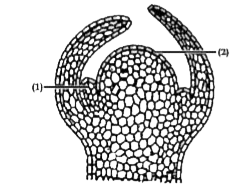Draw a neat labelled diagram of a vernier callipers.
Step-by-Step Text Solution for Drawing a Vernier Caliper
Step 1: Gather Materials
To draw a neat labeled diagram of a Vernier caliper, you will need:
- A sheet of paper
- A pencil
- A ruler (for straight lines)
- An eraser (for corrections)
Step 2: Draw the Main Body
Start by drawing a long rectangular shape to represent the main body of the Vernier caliper. This will be the part where the main scale is located.
Step 3: Add the Main Scale
On the top part of the rectangular body, draw a straight line with equal divisions to represent the main scale. Label this line as "Main Scale" and indicate the divisions (e.g., 0, 1, 2, 3, etc.).
Step 4: Draw the Vernier Scale
Below the main scale, draw another smaller rectangular shape that is slightly shorter than the main scale. This will represent the Vernier scale. Label this as "Vernier Scale" and also indicate its divisions (e.g., 0, 1, 2, 3, etc.).
Step 5: Add the Jaws
At one end of the main body, draw two upper jaws that are slightly open. These jaws are used for measuring internal dimensions. Label them as "Upper Jaws."
At the other end, draw two lower jaws that are also slightly open. These jaws are used for measuring external dimensions. Label them as "Lower Jaws."
Step 6: Draw the Sliding Arm
Draw a horizontal line connecting the Vernier scale to the jaws. This represents the sliding arm of the Vernier caliper. Label it as "Sliding Arm."
Step 7: Label the Diagram
Make sure to label all parts clearly, including:
- Main Scale
- Vernier Scale
- Upper Jaws
- Lower Jaws
- Sliding Arm
Step 8: Final Touches
Go over your pencil lines with a pen for clarity, and erase any unnecessary pencil marks. Ensure that the diagram is neat and all labels are legible.
To draw a neat labeled diagram of a Vernier caliper, you will need:
- A sheet of paper
- A pencil
- A ruler (for straight lines)
- An eraser (for corrections)
Start by drawing a long rectangular shape to represent the main body of the Vernier caliper. This will be the part where the main scale is located.
On the top part of the rectangular body, draw a straight line with equal divisions to represent the main scale. Label this line as "Main Scale" and indicate the divisions (e.g., 0, 1, 2, 3, etc.).
Below the main scale, draw another smaller rectangular shape that is slightly shorter than the main scale. This will represent the Vernier scale. Label this as "Vernier Scale" and also indicate its divisions (e.g., 0, 1, 2, 3, etc.).
At one end of the main body, draw two upper jaws that are slightly open. These jaws are used for measuring internal dimensions. Label them as "Upper Jaws."
Draw a horizontal line connecting the Vernier scale to the jaws. This represents the sliding arm of the Vernier caliper. Label it as "Sliding Arm."
Make sure to label all parts clearly, including:
- Main Scale
- Vernier Scale
- Upper Jaws
- Lower Jaws
- Sliding Arm
Go over your pencil lines with a pen for clarity, and erase any unnecessary pencil marks. Ensure that the diagram is neat and all labels are legible.
Topper's Solved these Questions
- MEASUREMENTS AND EXPERIMENTATION BOOK - ICSECHAPTER - MEASUREMENTS AND EXPERIMENTATION EXERCISE - EXERCISE 1(B) (Multiple Choice Type)
3 Videos
- MEASUREMENTS AND EXPERIMENTATION BOOK - ICSECHAPTER - MEASUREMENTS AND EXPERIMENTATION EXERCISE - EXERCISE 1(B) (Numericals)
23 Videos
- MEASUREMENTS AND EXPERIMENTATION BOOK - ICSECHAPTER - MEASUREMENTS AND EXPERIMENTATION EXERCISE - EXERCISE 1(A) (Numerical)
8 Videos
- MAGNETISM BOOK - ICSECHAPTER - MAGNETISM EXERCISE - EXERCISE-10(B) (Multiple Choice Type)
2 Videos
- MOTION IN ONE DIMENSION BOOK - ICSECHAPTER - MOTION IN ONE DIMENSION EXERCISE - EXERCISE -2 (C) ( Multiple choice type :)
17 Videos
Similar Questions
Draw a neat labelled diagram of an animal cell.
View SolutionDraw a labelled diagram of a nephron.
View SolutionThe diagram given below represents a process occurring in a flower.

Draw a neat, labelled diagram of a carpel.
View SolutionDraw a labelled diagram of a neuron.
View SolutionDraw a labelled diagram of a neuron
View SolutionDraw a neat and labelled diagram of a neuron.
View SolutionStudy the diagram given below and answer the questions that follow :

Draw a neat, labelled diagram of a meristematic cell.
View SolutionDraw a labeled diagram of sperm.
View SolutionDraw a labeled diagram of sperm.
View SolutionDraw a neat and labelled diagram of a plant cell.
View Solution
